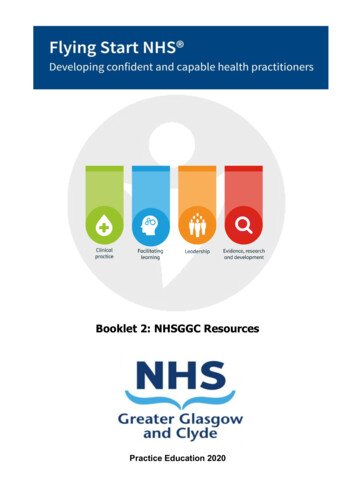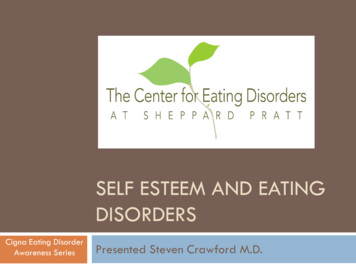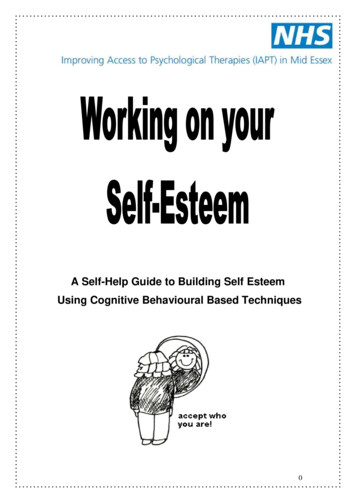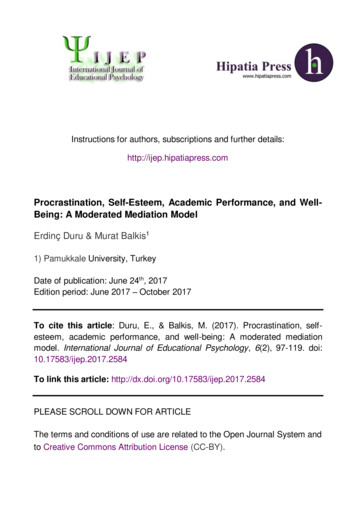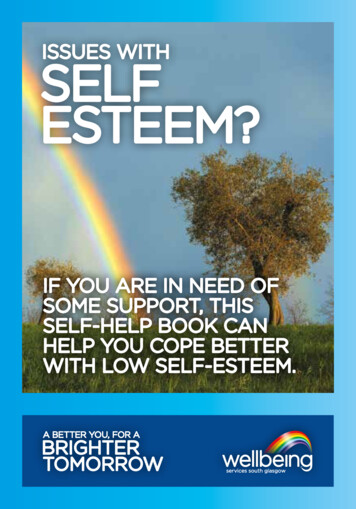
Transcription
ISSUES WITHSELFESTEEM?IF YOU ARE IN NEED OFSOME SUPPORT, THISSELF-HELP BOOK CANHELP YOU COPE BETTERWITH LOW SELF-ESTEEM.A BETTER YOU, FOR ABRIGHTERTOMORROW
SELF-ESTEEMSELF-HELP BOOKLETCONTENTSSection 1: 3-6··What is Self-Esteem?Section 2: 7 - 12··Self-Esteem and ThinkingSection 3: 13 - 18··AssertivenessSection 4: 19 - 26··Self-Esteem and BehaviourSection 5: 27 - 30··Noticing Positive QualitiesThis booklet is divided into seven sections.It is aimed at helping you to gain a betterunderstanding of: Self-esteem and how it develops What can happen when you have low self-esteem What keeps low self-esteem going Effective ways to improve your self-esteemWhether you are someone who generally has healthyself-esteem but experiences occasional moments of self-doubtin certain situations, or someone who is beset by self-criticalthoughts and finds it difficult to think of anything good aboutyourself - or somewhere in between - this self-help booklet couldbe helpful to you.The booklet aims to help you to deal with self-esteem problemsusing techniques from a well-established psychological treatmentknown as Cognitive Behavioural Therapy (CBT).1Section 6: 31 - 32··ReviewSection 7: 33 - 37··Wellbeing resourcesThere are various exercises throughout the booklet to help youunderstand your own self-esteem and to help you learn ways toimprove it. Like any new skill, it may take a bit of time and practicebefore you notice any changes in the way you feel.The exercises in this booklet are identified by ‘Stop & Think’. To gainthe most from these, it is important that you take some time tothink about the questions asked, and to complete the exercises.It may be that it will take several readings of it before you start towrite things down. That’s okay, just take your time. It is helpful toread each section thoroughly before moving on to the next.Try to praise yourself for every step you take.2
STOP & THINKSECTION 1:WHAT IS SELF-ESTEEM?Take a few moments to write a short description ofyourself. Consider how you think and feel about yourself.You might want to start with ‘I am ’Self-esteem can generally be defined asthe opinion we have of ourselves, ourevaluation of our worth and the value weconsider ourselves to have as people.This includes the thoughts we have about ourselves and ourabilities, the kind of person we think we are and our expectations.We all have an opinion of ourselves, therefore we all have selfesteem. The value we consider ourselves to have will vary fromperson to person. Our life experiences play a significant role indetermining whether we have healthy self-esteem or low selfesteem. If your life experiences have generally been positive, thenit is likely that the beliefs you have about yourself will also bepositive and that you will have healthy self-esteem.On the other hand, if your life experiences have generally beennegative, then it is likely that the beliefs you have about yourselfwill also be negative. It is these negative beliefs about yourselfwhich form low self-esteem. Most people have had a mixture ofboth positive and negative life experiences and tend to have arange of different beliefs about themselves which they can applyflexibly depending on the situation in which they find themselves.Self-esteem can affect all aspects of our lives on a day-to-daybasis, including how we think, feel and behave.Self-esteem is important as it is considered to be a significantmeasure of our psychological wellbeing.3Now reflect on what you have written about yourself. Whatwords did you use to describe yourself? Would you say that yourdescription of yourself is positive, negative, or balanced? Whatvalue did you place on yourself? Would you say that it is positive,negative, or balanced?WHAT IS LOW SELF-ESTEEM?When people have low self-esteem, they tend to have deep rootednegative beliefs about themselves and the type of person theyare. These beliefs are often accepted as absolute facts about theiridentity. They tend to place little value, if any, on themselves as aperson of worth. They are likely to be overly critical of themselves,their actions, and their abilities. People with low self-esteem tendto put themselves down, consider themselves to be inferior toothers, doubt themselves, and blame themselves when thingsgo wrong. People with low self-esteem may label themselves as‘stupid’, ‘worthless’, ‘useless’, ‘unattractive’, ‘unlovable’ or ‘a failure’to name a few.4
Below, four people reflect on how they feel about themselves.Although they focus on different aspects of themselves, they allhave one thing in common; they all have low self-esteem.Rachel, 45: “I find that I am always asking my husband and daughterif I look okay. I ask constantly before I leave the house and even whenwe are out. Sometimes I change my clothes numerous times beforeleaving the house, despite my family assuring me that I looked good inmy original outfit. I just never think that I look good enough and worrywhat others will think of my appearance.”Tom, 38: “I feel as though I don’t have a voice. I find that I go alongwith other people’s point of view even if I disagree with them. I wish Icould express my own views but I just can’t. I tell myself that I’m a loser,my views aren’t important and that no-one is interested in what I haveto say. I can’t stand up for myself at all and if I did, I think that peoplewould probably dislike me.”Linda, 57: “I can’t take compliments at all. If someone says somethingnice to me or praises me I think that they are lying to make me feelbetter. I can’t give myself credit for anything I have done well andconstantly undermine my achievements. I tend to focus on how I couldhave or should have done better. I tear strips off myself. I tell myselfI’m not good enough. Come to think of it, I wouldn’t talk to my worstenemy the way I talk to myself!”Sam, 25: “I feel so self-conscious when I am out. I am convinced thatpeople are looking at me and making judgments about me. I alwaysthink that people are thinking I’m ugly or weird. I hate walking into aroom full of people. I become really aware of myself and begin to tenseup. Sometimes I even begin to sweat and can feel myself blushing.This really embarrasses me as I’m sure that people notice. I’m oftenconvinced they have been talking about me.”HOW DOES SELF-ESTEEM DEVELOP?Early life experiences play a significant role in the developmentof self-esteem. The experiences that you had and how you weretreated in your childhood and adolescent years, will affect how youthink of yourself as an adult. The boxes below summarise some ofthe early life experiences which are associated with healthy selfesteem and low self-esteem.5HEALTHY SELF-ESTEEMLOW SELF-ESTEEM Listened to Ignored Praised Constantly criticised Given attention Lack of Praise or affection Treated with respect Neglected Getting along with others Abused Success at school or sports Different to others Given opportunities Not doing well at school or Having mistakes & failuresrecognised & accepted Feeling loved Unconditional lovein sports Living in a bad area Made to feel that not beingperfect was a weakness Made to feel unworthy ofbeing loved Conditional love – ‘I will loveyou if ’Although the beliefs we have about ourselves are, to a large extent,learned and formed in childhood and adolescence, what happensto us in our adult life can also affect our self-esteem. Someexamples of things which may affect our self-esteem in adulthoodinclude financial troubles, our appearance, excessive or harshcriticism, physical, sexual, or emotional abuse, chronic pain andillness, relationship difficulties, or traumatic events.Low self-esteem can also be a consequence of other problems,for example, depression, long standing anxiety, or severe stress. Ifyou think that the negative beliefs you have about yourself are asymptom of another problem, then tackling the root problem maybe the most effective way to proceed. It is likely that when the rootproblem has been treated successfully, low self-esteem will nolonger be an issue. If you feel that you would like help with anotherproblem, then Wellbeing Services may be able to help.For more information you can visit our website atwww.wellbeing-glasgow.org.uk or call us on 0141 232 2555.6
STOP & THINKSTOP & THINKConsider the roots of your self-esteem. Write downsome of the experiences in your life, perhaps as a childor in adolescence, or even in adulthood which may havecontributed to the negative beliefs and opinions youhave about yourself.The list of statements below are related to your generalfeelings about yourself. Take some time to consider eachstatement and indicate how strongly you agree or disagreeby ticking the appropriate box. There are no right or wronganswers here – just the truth about how you see yourself.StronglyAgreeTry to accept that the negative beliefs and opinions you have aboutyourself are an understandable reaction to your life experiences but remember that they are not necessarily true or factual.WHEN IS LOW SELF-ESTEEM A PROBLEM?We can all be dissatisfied and unhappy with ourselves atsome point or another. Sometimes life events such as job loss,relationship breakdowns, or illness can dent our self-esteem. Forthe majority of people, however, these dents to self-esteem aretemporary. If you find that you constantly think about yourself innegative terms and find it hard to think of anything good aboutyourself, then you may have a problem with low self-esteem.7AgreeDisagreeStronglyDisagree1.On the whole, I amsatisfied with myself.32102.At times, I think I amno good at all.01233.I feel that I have anumber of goodqualities.32104.I am able to dothings as well asmost other people.32105.I feel I do not havemuch to be proud of.01236.I certainly feeluseless at times.01237.I feel that I’m aperson of worth, atleast on an equalplane with others.32108.I wish I could have morerespect for myself.01239.All in all, I aminclined to feel that Iam a failure.012310.I take a positiveattitude toward myself.3210Rosenberg, M. (1989) Society and the Adolescent Self-Image. Revisededition. Middletown, CT: Wesleyan University Press.When you have completed this, add up your scores for eachanswer. The higher the score, the higher the self-esteem. If youscored below 15, then it is possible that you have low self-esteem.8
HOW LOW SELF-ESTEEM AFFECTS US Not being assertive and Doing things that they don’tLow self-esteem can affect how we think, how we feel, bothemotionally and physically and how we behave and each of theseareas can influence the others. Eagerness to please others Taking responsibility/It affects how we think When you have low self-esteem, you oftenhave self-critical thoughts and negative beliefs about yourself andthe kind of person you are. You will tend to dismiss positives aboutyourself and focus on weaknesses and flaws. Typically, someone withlow self-esteem might: Think that they are notgood enough Worry about what othersthink of them Blame themselves for things Automatically assume thatthey can’t do things withouteven trying Dwell on criticism andperceived mistakesexpressing their wants,needs and opinionsand gain others’ approval Reacting over sensitively Constantly seekingreassurance that thingsare okayagree with or that they don’twant to doblaming themselves forthings that have nothing todo with them or are nottheir fault Comfort eating or closelymonitoring weight Being overly apologeticBody language such as poor posture, lack of eye contact, downturnedhead and hesitancy may also be a sign that you have low self-esteem.that aren’t their faultIt affects how we feel emotionallyIf you have a low opinion of yourself and you are constantly puttingyourself down, you may begin to feel a range of negative emotionsincluding feeling sad and unhappy, depressed, anxious, guilty,ashamed, frustrated, angry and so on.STOP & THINKTake some time to consider and write down how lowself-esteem affects you on a day-to-day basis. Whatareas of your life are affected? In what way?It affects how we feel physicallyIf your emotions are negatively affected by low self-esteem, this mayhave an impact on how you feel physically. You may notice that youexperience uncomfortable bodily sensations such as fatigue, lack ofenergy, headaches, blushing, and tension, to name a few.It affects how we behaveLow self-esteem can affect your behaviour and how you act ineveryday situations. It can have an impact on how you behave atwork, in your relationships and in your leisure time. Some of thetypical behaviours of people with low self-esteem include: Avoidance – not going out orseeing people Avoiding activities thatinvolve being judged e.g.competitive sports Working too hard, tryingto be perfect in everythingthey do9 Not engaging in enjoyableactivities because they don’tbelieve that they deserve torelax or enjoy themselves Passing up new challengesor opportunities Avoiding speaking out10
WHAT KEEPS LOW SELF-ESTEEM GOING?Low self-esteem is often kept going by the self-critical thoughtsand beliefs we have about ourselves based on past experiences.These can be triggered by criticism or perceived criticism fromothers. The negative opinion we have about ourselves can affecthow we feel and lead to unhelpful behaviours, which reinforceour low self-esteem and make us feel even worse about ourselvescreating a ‘vicious cycle’.Let’s look at an example to illustrate.Imagine you are at work and your boss points out some mistakesthat you have made in a report. You may begin to think that youare rubbish at your job and question your ability. You may tellyourself that nothing you do is ever good enough and that unlessyou work harder you will mess up again, get criticised again orworse lose your job.These type of thoughts would naturally cause you to feel bad aboutyourself perhaps ashamed, depressed, anxious and worried. Sowhat you think has affected how you feel.You may begin to notice physical changes in your body such asfeeling sick, headache, disturbed sleep and lack of concentration.You may then begin to work too hard and neglect yourself, becomeoverly apologetic and desperately try to please others, seekreassurance from your colleagues, or make even more mistakesbecause you are so tired (behaviour). This behaviour reinforceswhat we think of ourselves and maintains low self-esteem.The following diagram links these areas together.This diagram shows us that what we think about a situation affectshow we feel, physically and emotionally and changes what we do.What we do then confirms what we think about ourselves and sothe ‘vicious cycle’ keeps going.This self-help booklet aims to help you to weaken the ‘vicious cycle’by helping you to deal with the unhelpful thinking habits and selfdefeating patterns of behaviour that keep it going.SituationBoss points out mistakes in your reportSelf-critical thoughts“My boss is right. I’m rubbish at my job” “Nothing I do is evergood enough” “I’ve got to work harder or I’ll mess up again”Altered feelingsAshamed, depressed,anxious, worriedAltered physical symptomsFeeling sick, headaches,disturbed sleep etcAltered behaviourWork too hard and neglect yourself. Try to please others and becomeoverly apologetic for things that have little to do with you. Seekreassurance from colleagues. Make more mistakes .SUMMARY Self-esteem can generally be defined as the opinion we have ofourselves, our evaluation of our worth and the value we considerourselves to have as people. When people have low self-esteem, they tend to have deeprooted negative beliefs about themselves and the type of personthey are. Our life experiences, particularly in our childhood and adolescentyears, play a significant role in determining whether we havehealthy self-esteem or low self-esteem. Low self-esteem can affect how we think, feel and behave andeach of these areas can influence the others. Low self-esteem is often kept going by self-critical thoughts andunhelpful patterns of behaviour, creating a ‘vicious cycle’.1112
FEATURES OF NEGATIVE AUTOMATIC THOUGHTSSECTION 2:SELF-ESTEEM AND THINKING They are automatic – they pop into your head, you are oftenunaware of them and they seem to come from nowhere. They may seem reasonable at the time and often you acceptthem as absolute fact or truth without question. They are hard to stop. They are the kind of thoughts that, if they were true, would havea negative impact on most people’s self-esteem.UNHELPFUL THINKING STYLESMost of the thoughts we have when we experience low self-esteemtend to fall into some common categories which we call unhelpfulthinking styles (or cognitive distortions) as outlined below.STOP & THINKAs you read through the unhelpful thinking styles,place a tick next to those you think are most relevantto you.If you have low self-esteem it is likelythat you will experience negativeself-statements and self-critical thoughtson a daily basis.These self-statements and thoughts form the overall opinion thatyou have about yourself. You may think of these thoughts as your‘inner critic’ – the voice in your head that never has anything goodto say about you. Your thoughts are strongly related to how youfeel, therefore if you are constantly experiencing negative thoughtsabout yourself, it is likely that you will feel bad about yourself andsuffer a great deal of emotional distress. These type of thoughtsare called negative automatic thoughts.13Mental Filter: Focusing ononly one part of a situation orone part of yourself andignoring the rest. This usuallyinvolves focusing on thenegative part of a situation oryourself and dismissing thepositives and/or your successes.Mind-Reading: Assumingthat you know what otherpeople are thinking(usually about you), when infact communicating with aperson and asking what theythink, is the only way of actuallyknowing what they think.Example: After having delivereda presentation at work youreceive a lot of positive feedback.One colleague however makes aslight criticism of one aspect ofyour presentation. You dismissthe positive feedback fromthe majority and focus on thenegative, until eventually youbelieve that the presentation waspoor and that you are no good atthese or public speaking.Examples: “I’ve never spoken toher but I just know she doesn’tlike me.”“He’s thinking that I don’t knowthe first thing about doing myjob correctly.”“I better not suggest that idea,he’ll think I’m stupid.”“She doesn’t understandwhat I mean.”14
Magnification andMinimisation: Magnifyingthe positive attributes ofother people and minimisingyour own positiveattributes. Constantlyundermining yourself.Example: “Getting thatpromotion doesn’t mean I’m anygood at my job, it was just luck.Other people are far better at therole than me. They have far bettercommunication skills and they aremuch better at writing reports.”‘Shoulds’ and ‘Musts’:By constantly thinking orsaying ‘I should’ and ‘I must’,you can put unreasonabledemands or pressure onyourself. This can sometimescreate unrealistic expectations.Examples:“Making a mistakewould be a disaster. I shouldnever make a mistake”.“I must ensure that I pleaseeveryone all of the time.”All or nothing thinking:Seeing only one extreme oranother and no in-between.Believing that something, orsomeone, can only be good orbad, right or wrong and so on.15Over generalisation: Takingone experience in the past orpresent and imposing it on allcurrent or future situations.Examples: “I wasn’t successful atmy first couple of job interviews.I’ll never get a job.”“I never have luck in relationships.I always mess up.”Labelling: Assigning labelsto ourselves or other people –often negative labelsExamples:“My son is doingbadly at school. I must be abad mother.”“I didn’t get that promotion, I’msuch a loser.”“I’m just a boring person really.”IDENTIFYING NEGATIVE AUTOMATIC THOUGHTSWhen you notice a change in how you feel (e.g. sad, angry,irritable), take time to examine what is going through your mind.Often it is hard to do this as so many thoughts go through yourmind all the time and can become muddled up. When you feel badabout yourself, try tuning in to your ‘inner critic’. Ask yourself“What was I thinking about just then?” “What was my ‘inner critic’saying to me?”Noticing the negative thoughts you experience is important if youare to begin tackling them. You can train yourself to notice yourthoughts. One way of doing this is to use a thought diary.THOUGHT DIARYThought diaries can provide a way of recording your thoughts,identifying negative, self-critical thoughts and becoming moreaware of them. When learning a new skill, it’s useful to go back tobasics. Writing it down can help!The following table gives an example of a thought diary and howto complete it.STOP & THINKThought DiaryPersonalisation: Blamingyourself or taking responsibilityfor everything that goes wrongor could go wrong even whenyou may only be partlyresponsible or not responsibleat all.Examples: “If I was a betterhusband my wife wouldn’t havehad an affair.”“If everyone at my party doesn’thave a good time it’ll be my fault.”Date/time:When you had the negative/self-critical thoughtSituation:The place where you had the self-critical thought. You may alsowant to note who was with you, anything that was happening atthe time and what was said.Mood:How you felt at the time, for example did you feel embarrassed,upset, ashamed, or angry?Examples:“If it’s not perfect,I’ve failed.”Thought:Write down the self-critical thought. What was going through yourmind at that time?“If I don’t look my absolute besttonight then there is no point ingoing out.”How much do I believe the self-critical thought?On a scale of 0-10, rate how much you believe the thought(0 not at all, 10 completely believe)16
Here is Rachel’s EFRATING20thMarch,7pmGettingready to goout, tryingon differentoutfitsUpset,irritated,angryI am fat and ugly,nothing I put on looksgood. There is no pointgoing out lookinglike this, I will onlyembarrass my friends.1021stMarch,11amIn meeting atworkAnxious,nervousI’m not good enough8to be in this job. Myopinion doesn’t matter, Ijust talk rubbish anyway.For the next week or so, write down any negative/self-criticalthoughts you have about yourself as you go about your day. Try toget into the habit of noticing them. Notice if any of them fall intothe unhelpful thinking styles categories we looked at previously.This can be quite difficult. Like all skills, you will get better at it withpractice. So don’t worry about taking a long time over this beforemoving on to the next section. It may be helpful to ask a friend orfamily member to help you – they may be able to prompt you toremember the unhelpful, negative thoughts you experienced.Think of yourself as a detective – trying to string together cluesto what triggers and perpetuates your low self-esteem. Carrypaper and a pen with you (or use your phone) so you can notethings down just after they happen. If you can’t do it at the time,try to recall and write down the thoughts as soon as possible afterthe event.CHALLENGING NEGATIVE AUTOMATIC THOUGHTSOne of the main problems with negative automatic thoughts is thatwe often accept them as absolute facts or truths rather than whatthey actually are – just our view or opinion. It is this unquestioningacceptance of our thoughts which helps our ‘inner critic’ to thriveand continue to have a negative impact on our self-esteem. Thenext step after identifying negative automatic thoughts, therefore,is to learn to challenge them and develop a more realistic, balancedpoint of view.One of the most straightforward ways to challenge unhelpfulthoughts is to weigh up the evidence for and against them and trycome to a more balanced way of thinking.17What is the evidence?Think of it like a jury in a court case. To know the truth we need topull together information/hard facts about what actually happened(not just what we think happened). For example if a person with lowself-esteem thinks “I am fat and ugly, nothing I put on looks good, thereis no point going out, I will only embarrass my friends”, we can look atthe evidence for and against. Is this true, or is it just your opinion?Evidence for: Refers to the information that you feel backs up yourthought. What makes you think this? It may be how you feel now, orabout previous experiences.Evidence against: Refers to the information that doesn’t back up yourthought or contradicts your thought. It may be things that your familyor friends have said to you, or about past experiences.Balanced coping thought: When you’ve considered all the evidence,try to come to a more balanced, realistic perspective about the situation.You can then learn to remember this every time your ‘inner critic’ speaks.Re-rate belief: When you have considered all the evidence and cometo a more balanced, realistic perspective about the situation, re-ratehow much you believe your original thought. You should find that youdo not believe it as much as you did before you looked at all of theevidence and that you feel better about things.Rachel challenges her self-critical thought from earlier in the diary below.NEGATIVE THOUGHT(S)I am fat and ugly, nothing I put on looks good. There is no point going outlooking like this, I will only embarrass my friends.EVIDENCE FOREVIDENCE AGAINSTThe dress I want to wear feels tootight – I’ve definitely put weight on.My ex-partner said I was ugly.I can’t think of any evidence that myfriends would be embarrassed byme other than I think it.I’ve put on a few pounds – itdoesn’t mean I’m fat.My ex-partner was a bully, he neversaid anything nice to anyone.My friends have told me that theylike me for the person that I amand not what I look like/wear.BALANCED, REALISTIC PERSPECTIVEEven though I’ve put on a few pounds and my favourite dress felt a bittight, it doesn’t mean I’m fat. Lots of people have given me complimentsand yet I always think about the nasty things that my ex-partner said. Hisopinion doesn’t make it a fact. Friends have told me time and time againthat they are interested in me as a person not what I’m wearing.BELIEF RATING318
It can be difficult to think through the evidence for and against yourthoughts. Sometimes it can help to ask a friend or loved one tohelp you with this task.There are other questions that you can ask yourself whichmight help you challenge your self-critical thoughts. Theseare listed below.STOP & THINK Is the ‘inner critic’ at work again? Are you comparing yourself to others, focusing on yourweaknesses and others people’s strengths? Are you ignoring your strengths and focusing onyour weaknesses? Are you taking responsibility or blame for something that wasn’t(totally) in your control? What might you say to someone else if they said this to you? What might a friend or loved one say about the situation orabout you? What could you say to yourself that is more helpful andless critical? Have you made a mistake? If so that’s okay, we all makemistakes. What can you learn from the situation?The goal of this task is to teach you to recognise and tacklenegative, self-critical thoughts which make you feel bad aboutyourself and which negatively impact your self-esteem. Ideally inthe end you will have learned this skill and will be able to apply itany time you need it. In the beginning it will be helpful to write thethoughts down in a table as it will help you both identify and tacklethem in a structured way.As time progresses, you may find that you only need to note theunhelpful thought and the balanced coping thought, or eventuallyyou can learn to do this in your head.This is not likely to happen overnight.Challenging thoughts is a new skill. Like learning any new skill itwill take time. Remember to reward yourself for your efforts withpraise and/or treats.If you wish to find out about identifying and tackling unhelpfulthoughts, there are several workbooks that can lead you throughexamples of people learning to tackle their unhelpful thinking.‘Manage your Mind’ is an excellent workbook which is available inall libraries in the South of Glasgow, as well as bookstores.SUMMARY When you feel bad about yourself, notice what you say toyourself, your ‘inner critic’. Is there anything you can do about your negative thoughts? You can learn to challenge unhelpful, self-critical thoughts andreplace them with more helpful, realistic thoughts which canhelp you to improve your self-esteem. Does this way of thinking help or benefit you in any way? How? There are a number of questions you can ask yourself to help youchange the way you think about yourself. Does this way of thinking hold you back? How? It will take time to learn this new skill.(E.g. change diet, lifestyle) If yes, what? Make a plan!19THE GOAL20
COMMUNICATION STYLESSECTION 3:ASSERTIVENESSAssertiveness is a style of communicationin which people clearly state their thoughts,beliefs, needs and opinions to anotherperson, while maintaining respect for thatperson in the interaction.Assertiveness enables a person to stand up for themselves, to actin their own best interests and to express their honest feelingscomfortably. Assertiveness is strongly related to a sense of selfworth; the belief that you have the same rights, responsibilities andpersonal value as other people. If you have low self-esteem, youwill perhaps place very little value on yourself as a person of worthand find it extremely difficult to be assertive and express yourthoughts, feelings, needs and opinions. It may be that you are ableto be assertive in some situations (e.g. at home) but not so much inothers (e.g. at ve, puts selfdown, praises others.Firm but polite, clearmessages, respectfulof self and others.Believes that otherpeople’s opinionsare more importantthan their own, so itdoesn’t matter whatthey think anyway.Believes or acts asif all the individualsinvolved are equal,each deservi
Effective ways to improve your self-esteem Whether you are someone who generally has healthy self-esteem but experiences occasional moments of self-doubt in certain situations, or someone who is beset by self-critical though

